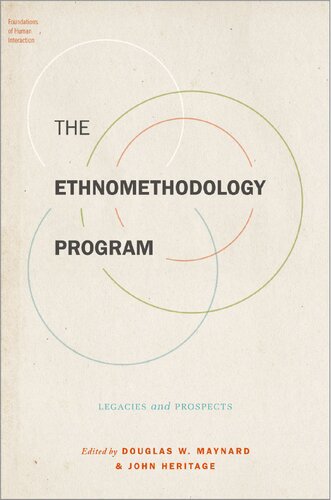The Ethnomethodology Program: Legacies and Prospects Douglas 019085443X 9780190854430
$50.00 Original price was: $50.00.$25.00Current price is: $25.00.
This completed downloadable of The Ethnomethodology Program: Legacies and Prospects Douglas W. Maynard

Instant downloaded The Ethnomethodology Program: Legacies and Prospects Douglas W. Maynard pdf docx epub after payment.
Product details:
- ISBN-10: 019085443X
- ISBN-13: 9780190854430
- Author: Douglas W. Maynard
It’s been more than fifty years since Harold Garfinkel created the field of ethnomethodology–a discipline that offers a new way of understanding how people make sense of their everyday world. Since his book Studies in Ethnomethodology published in 1967, there has been a substantial–although often subterranean–growth in ethnomethodological (EM) work. Studies in and appreciation of ethnomethodological work continue to grow, but the breadth and penetration of his insights and inspiration for ongoing research have yet to secure their full measure of recognition. This volume celebrates Harold Garfinkel’s enormous contributions to sociology and conversation analysis, exploring how ethnomethodology emerged, the empirical consequences of Garfinkel’s work, and the significant contemporary work that has resulted from it. Douglas W. Maynard and John Heritage bring together experts from a wide range of theoretical and empirical areas to create the first comprehensive collection of work on EM that encompasses its role in “studies of work,” in Conversation Analysis, and in other subdisciplines. Chapters highlight ethnomethodology’s distinctive forms of ethnographic inquiry and its influences on a host of substantive domains including legal environments, science and technology, workplace and organizational inquiries, survey research, social problems and deviance, and disability and atypical interaction. The book explains how EM especially helped to set the agenda for gender studies, while also developing insights for inquiries into racial and ethnic features of everyday life and experience. Still, there is much of what Garfinkel called “unfinished business,” which means that ethnomethodological inquiries are continuing to intensify and develop. Harold Garfinkel and Ethnomethodology ddresses this unfinished business: not only drawing attention to past accomplishments in the field, but also suggesting how these accomplishments set the stage for future endeavors that will benefit from EM-inspired approaches to social organization and interaction.
Table of contents:
1. Ethnomethodology’s Legacies and Prospects
Part I: Antecedents and Theory
2. A Comparison of Decisions Made on Four “Pre-Theoretical” Problems by Talcott Parsons and Alfred Schütz
3. Harold Garfinkel’s Focus on Racism, Inequality, and Social Justice: The Early Years, 1939–1952
4. Garfinkel’s Studies of Work
Part II: Empirical Impact
5. Sources of Issues and Ways of Working: An Introduction to the Study of Naturally Organized Ordinary Activities
6. Rules and Policeable Matters: Enforcing the Civil Sidewalk Ordinance for “Another First Time”
7. The Cooperative, Transformative Organization of Human Action and Knowledge
8. Sex and the Sociological Dope: Garfinkel’s Intervention into the Emerging Disciplines of Sex/Gender
9. Garfinkel, Social Problems, and Deviance: Reflections on the Values of Ethnomethodology
10. The Ethnomethodological Lineage of Conversation Analysis
Part III: Growth Points
11. The Situated and Methodic Production of Accountable Action: The Challenges of Multimodality
12. Recovering the Work of a Discovering Science with a Video Camera in Hand: The Electronically Probed/Visually Discovered Spectrum
13. Research with Numbers
14. The Sherlock Experiment
15. Technology in Practice
16. Occam’s Razor and the Challenges of Generalization in Ethnomethodology
17. Ethnomethodology and Atypical Interaction: The Case of Autism
People also search:
the ethnomethodology program legacies and prospects
what is ethnomethodology theory
what is ethnomethodology
what is ethnomethodology garfinkel
what is ethnomethodology in research
what are some examples of ethnomethodology
You may also like…
Business & Economics
Uncategorized
Technique - Construction
2021 International Building Code® Illustrated Handbook 1st Edition by Douglas W. Thornburg
Politics & Philosophy - Politics
Ideology and Mass Killing: The Radicalized Security Politics of Genocides and Deadly Atrocities
Politics & Philosophy - Government & Politics
Politics & Philosophy - Anthropology
Fiction
Technique - Construction
2021 International Building Code Illustrated Handbook 1st Edition
Computers - Security












